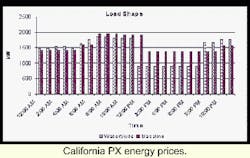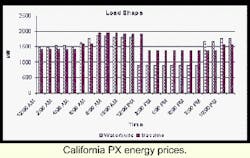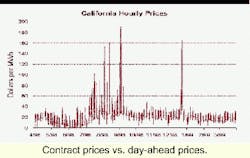COMPUTERS AND AUTOMATION TECHNOLOGY: Optimization Savings Opportunities: Deregulated vs. Regulated Pricing
By Richard A. Jamieson and Scott E. Dunham
The North American electricity industry is transitioning from a vertically integrated monopoly business to a segmented industry with open markets for electric power generation and regulated transmission and distribution businesses.
One result of the state-by-state deregulation currently underway is that the market is divided into two segments: deregulated and still-regulated. Opportunities exist in both segments of the market for water agencies interested in reducing energy costs.
Optimization Opportunities: Regulated Tariff Markets
In regulated electricity markets, most commercial and industrial ratepayers operate under a tariff structure that features two primary cost components, one for energy (kWh) and one for demand (kW). Both components may feature time and season-based pricing differentials. The energy component is typically linked to the cost of the raw materials used to generate power, while the demand charge is based on the cost of the infrastructure required to generate and deliver the power.
Under a tariff structure, the demand component of the electricity bill often accounts for 50-80 percent of total electrical cost. While optimum operational schedules generate the lowest overall costs in this environment, lowest cost is not always synonymous with "energy efficient" or the "lowest peak demand."
Typically, demand charge tariffs are characterized by the so-called "on-peak hours" when the price per kW is highest and when ratchet values are triggered that can last as long as 11 billing cycles. Under these tariff structures, the demand component of electricity bills is generally consistent throughout a 12-month period, with demand charges pinned to load incurred many months prior.
Most consumers perceive this as an unfair and devious practice; however, in reality, such tariffs allow customers to finance the cost of power-generation infrastructure on a "consistent-payment" basis. This way, customers do not have to deal with extreme payments during the relatively short times of the year when the peaking infrastructure is actually being used and the marginal cost of the next kW can be astronomically high.
Effective use of water storage can reduce demand charges and, therefore, significantly reduce annual costs. Once a demand charge has been set because of a bump in demand by a process necessity, storage can also be used to take advantage of operational flexibility under the new ceiling.
It is possible under a tariff structure to incur demand charges that figure into ratchet values even when operating outside of the "on-peak" hours. Thus, a rough off-peak pumping strategy can inadvertently result in higher ratchet values than a more balanced load plan.
The term "on-peak" is a misnomer. The period referred to usually is at least six hours long and often eight to 12 hours. Because elevated water storage is typically a scarce resource, scheduling water pumping operations around on-peak hours is akin to threading a needle there are infinite paths to almost make it, but only a limited opportunity to pass through the eye.
New adaptive prediction and scheduling software, coupled with industry-standard monitoring systems, can help utilities better manager their electrical load profiles, producing consistent, long-term results. What appear to be minor differences in load over time can result in significantly different costs under demand tariff structures.
As an added benefit, load management systems make water utilities a more attractive customer. Regulated electric utilities are interested in demand-side management programs that improve load profiles. If a water utility can demonstrate its optimization program will help control peak capacity spikes and improve load profiles, the local electricity provider may be motivated to help the utility gear up for optimal operations.
Optimization Opportunities: Competitive Retail Marketplaces
A competitive power market eventually will result in a shift from a cost-based orientation to a price basis in which supplier cost is transparent to customers. This shift can take years to occur, however, primarily because the pre-competitive, tariff-based costs inevitably become the benchmark for evaluating prices in a competitive market.
Price risk is a new factor in a competitive market, and this cost must be distributed among the customer base. As the marketplace becomes increasingly effective at allocating the true cost of price risk to the customer base, there will be greater opportunity to create value through optimization of load-intensive processes, such as water utility industry operations.
One thing that will not change in the transition from the vertically integrated monopoly structure of the power industry to the competitive commodity market form is the need to pay for capital (i.e., fixed infrastructure) and operating costs. In the absence of tariff structures that perform a leveling function in the payment of capital costs, the commodity price in a competitive market must incorporate capital and operating costs at the time of sale. While there may no longer be an explicitly defined "demand charge" and "energy charge, " bills will regardless somehow reflect both of these.
One of the positive characteristics of competitive markets is the ability to make choices. The deregulated power market frees participants to develop solutions to the capital/operating compensation problem that better meet the needs of both supplier and customer. The outcome will be a more precise and fluid matching of demand and supply on the power grid.
Power is a real-time commodity that cannot be stored to absorb fluctuations in demand. Consequently, mismatches between supply and demand create volatile conditions in the supply market. As an example, the California power exchange has seen widely fluctuating prices over the past two years. There have been many instances of power prices exceeding $1,000/MWh, and some instances of $5,000 and $10,000/MWh up to up to 285 times the typical price.
The long-term wholesale electric power futures market is a coarse market consisting of on-peak (16 hours) and off-peak products. In contrast, exchange markets dealing with day-ahead, hour-ahead, and real-time transactions are very detailed in pricing and much more volatile.
Volatility presents serious challenges to achieving economic efficiency, and with those challenges come opportunities for utilities willing to implement prediction and optimization technologies. Solutions that optimize pumping and load utilization in coordination with the power market are a natural and valuable fit for both the water utility industry and the power industry.
Prediction and control capabilities on the demand side (i.e., water agencies), combined with a water agency's storage capacity, enable load that is shifted during high demand periods to be sold at current market prices, creating a market efficiency and a significant economic benefit. Simulations indicate 30 percent or more savings from integrating demand-side management (DSM) with economic supply-side management systems.
Combining the capital and operating costs of power into a single price for a given period represents both opportunity and dilemma for customers. Opportunity is present in the higher resolution of pricing, where "on-peak" need not represent 6-12 hour periods, as it does in regulated tariffs, leaving many with the impression that there is little they can do to manage peak. There is, it just requires more rigor and investment in the solutions to achieve consistent results.
The dilemma is posed as the direct consequence of higher resolution in pricing: price volatility. When price is set in a marketplace as a function of supply and demand, the real-time nature of electric power makes this an extremely volatile market, with prices seen between near-zero and $10,000 per MWh.
Creating opportunity out of higher resolution pricing and price volatility requires advancing beyond simple broad-brush strategies to rigorous, structured methods. Prediction and control technology takes advantage of high-resolution pricing while managing system operation around price volatility to satisfy core competency system requirements of the user.
Software and systems that combine physical water assets, risk management, and financial instruments in the marketplace can create further benefit by leveraging real-time access to load data and the ability to influence it.
Higher resolution in pricing that incorporates fixed and operating factors into a one-time price, as compared to on-peak demand charge blocks of 6-12 hours, creates an environment in which demand-side management can be executed more precisely and to potentially greater effect. Just as in the regulated environment, the primary means of lowering the cost of power is to shift load.
High-resolution pricing widens the "eye of the needle" for accomplishing price management through load management. However, it also creates risk of exposure to radically high prices. These risks must be managed to present effective solutions to the water utility industry. The greater the volatility of the market for power, the more opportunity there is to gain from precise load shifting. The less volatile the market is, the more similar load shifting benefits are to the regulated environment.
Conclusion
Markets are efficient when supply and demand interact to find equilibrium of quantities and prices. Load shifting is an activity that increases market efficiency by reducing demand when price (cost) is high. Whether in a regulated tariff environment or a competitive commodity market, load shifting represents an economic efficiency gain.
About the Authors:
Richard A. Jamieson, Ph.D., is the CEO of Powerware Solutions Inc. (PSI). Scott E. Dunham is Head of Business Development for the company. Powerware Solutions provides innovative, value-added energy services to meet the challenges of deregulation and privatization facing today's water agencies. With its WaterSuite


